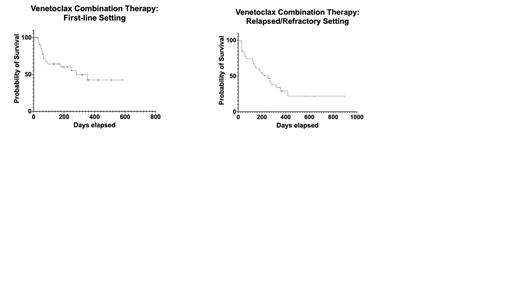Abstract
Background: The addition of venetoclax to a hypomethylating agent (HMA) backbone has been shown to augment responses when compared to HMA monotherapy or to low-dose cytarabine in the treatment of acute myeloid leukemia (AML). The aim of this retrospective analysis was to characterize venetoclax-based regimens in both the first-line and relapsed/refractory settings to determine efficacy and safety outcomes.
Patients & Methods: We retrospectively analyzed 74 patients treated with venetoclax in combination with decitabine, azacitidine, or low-dose cytarabine treated from June 2018 to December 2020. This analysis included 41 patients in the upfront setting and 33 patients in the relapsed/refractory setting. Baseline patient demographics were obtained alongside ECOG performance status at diagnosis, cytogenetics and molecular profiling, dates and doses of induction, toxicity, responses, MRD analysis, and allogeneic hematopoietic stem cell transplant (HSCT) outcomes. The event for calculating the overall survival was the date of death and patients were otherwise censored at the date of last contact.
Results: In the upfront setting of 41 patients, 25 (61%) were male and 16 (39%) were female, the median age was 72 (range: 37 - 85), the median ECOG score was 2 (range: 0 - 3), and the median Charlson Comorbidity Index (CCI) score was 6 (range: 3 - 12). There were four patients with favorable-risk cytogenetics (9.8%), six (14.6%) with intermediate cytogenetics, and 29 (70.7%) with adverse cytogenetics. Two (4.9%) patients had cytogenetics unknown at diagnosis. Eight (19.5%) had mutations in TP53. Thirty-three (80.5%) received venetoclax with 5-day decitabine, one (2.4%) with 10-day decitabine, six (14.6%) with azacitidine, and one (2.4%) with low-dose cytarabine. In the entire cohort, 37 (90.2%) experienced at least one grade 1 non-hematological toxicity during induction. Non-hematological adverse events were infection (58.5%), neutropenic fever (53.7%), and acute kidney injury (26.8%). Six (14.6%) patients had tumor lysis syndrome defined by Cairo-Bishop criteria and all six were spontaneous rather than therapy-induced. One (2.4%) died within 30 days of induction, nine (22.0%) died within 60 days, and 29 (70.7%) had no death during induction. Three (7.3%) achieved CR and 13 (31.7%) achieved CRi for an ORR of 39.0%. Two patients (4.9%) went on to receive HSCT. The median OS was 416 days (13.7 months) in the intermediate category and 281 days (9.2 months) in the adverse category. In the relapsed/refractory setting, 20 (60.6%) were male and 13 (39.4%) were female. The median age was 63 (range: 23 - 76), the median ECOG score was 1 (range: 0 - 4), and the median CCI score was 5 (range: 2 - 11). At the time of initial diagnosis, two patients (6.1%) had favorable cytogenetics, three (9.1%) had intermediate cytogenetics, 27 (81.8%) had adverse cytogenetics, and one had unknown cytogenetics. Seven (21.2%) patients had a TP53 mutation at initial diagnosis. Twenty-five (75.8%) received venetoclax with 5-day decitabine, 6 (18.2%) with azacitidine, one (3.0%) with low-dose cytarabine, and one with an unknown duration of decitabine. Common non-hematological toxicities included 13 (39.4%) with infection, 11 (33.3%) with neutropenic fever, and 3 (9.1%) with acute kidney injury. Five patients (15.2%) achieved CR and 5 (15.2%) achieved CRi for an ORR of 30.3%. Four (12.1%) died within 30 days, 3 (9.1%) within 60 days, and 25 (75.8%) with no death during induction. The median OS was 251 days (8.25 months).
Conclusion: The combination of venetoclax with decitabine, azacitidine, or low-dose cytarabine demonstrates an ORR of 39.0% in the upfront setting and the OS was 13.7 months and 9.2 months in the intermediate and adverse categories, respectively. The relapsed/refractory setting featured a shorter OS at 8.25 months and an ORR of 30.3%, which does not appear to be substantially different from historical data with HMA monotherapy in relapsed disease (mOS = 6.7 months). These findings raise the question regarding the benefit of venetoclax in the relapsed setting for selected patients. Additionally, our findings augment the small sample of available data on the utility of HMA/venetoclax, particularly in the treatment of relapsed disease, with recent retrospective data showing a CR/CRi rate of 24% and a mOS of 6.1 months. Prospective trial designs are needed to confirm these findings.
No relevant conflicts of interest to declare.


This feature is available to Subscribers Only
Sign In or Create an Account Close Modal